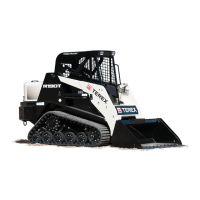2.12 Placing into Operation
• Every time before placing the machine into operation, perform a thorough
walk-around inspection of the machine.
• Check the machine for loose pins, cracks, tears, wear, leaks and deliberate
damage.
• Never place a damaged machine into operation.
• Make any necessary repairs immediately, prior to resuming operation.
• Inspect to make sure all warning signs are in place and legible, then close
and latch all hoods and covers.
• Make sure all windows (if equipped) are clean. Secure door and windows
against unintentional movements.
• If visibility is reduced by a lack of window or screen / lens clarity (yellowing,
scratches, damage, etc) replace affected components prior to operating.
• Make certain no one is working on or under the machine and warn any
persons standing nearby that the machine will be placed into operation.
• Prior to placing the machine into operation, adjust the driver’s seat, and
ventilation system settings (if equipped) so you can work in comfort
and safety.
2.13 Starting the Machine
• Before starting, check all indicator lamps and instruments to make certain
they are working properly.
• Start the engine in the manner described in the operating instructions.
• Only allow the engine to run in enclosed rooms if there is adequate
ventilation. If necessary, open doors and windows to ensure a proper supply
of fresh air.
• Bring the engine and hydraulic oil up to operating temperature. Low oil tem-
peratures can cause the control system to respond sluggishly.
• Move the machine carefully to open ground and then check the functionality
of the lift arm and drive controls as well as the lighting equipment.
2 SAFETY
20
RT-60/R160T/R190T ROW O&M
0404-659 2016-05

